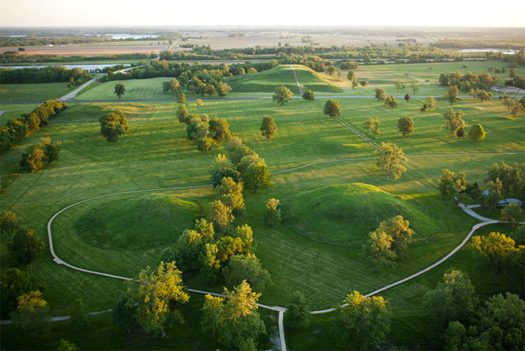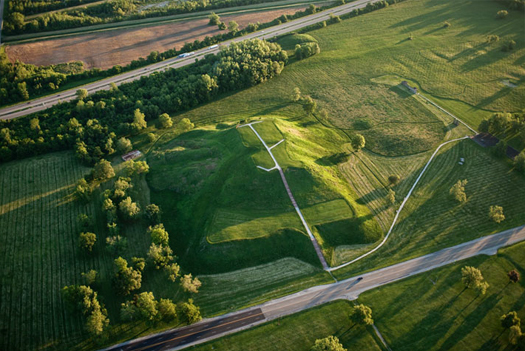

[Cahokia mounds, photographed by Ira Block for National Geographic; the mound immediately above is “Monk’s Mound”, the largest (ten stories tall) of the Cahokia mounds.]
Around a month ago, FASLANYC ran an excellent post that described the Mississippian mound culture as a potential source of inspiration for a reconsidered Louisiana delta urbanism. In the post, FASLANYC describes the mounds themselves as a “multifunctional networked infrastructure”:
“The Mississippians were a “mound-building people”, a fragmented and fractious empire loosely associated and bound together through cultural practices, trade, and their shared environmental situation. The capital was Cahokia — at the time the largest North American city north of Mexico — and is a prime example of this cultural practice of mound-building. While the archeological mounds are laden with cultural significance [and this is what anthropologists tend to focus on it seems], these constructions can also be seen as a dispersed, cellular adaptation to the dynamic hydrological condition of the Mississippi Valley.
We find it interesting that even in this year’s record high flood, the indian mounds near Kincaid, Illinois stayed dry. Trawling through the wildlife and game message boards, we came across this great thread where hunters are discussing the animals that have taken refuge on the local indian mounds, as well as the roofs of homes. This activity is not limited just to animals. In a 1927 issue of Science in an article titled “Indian Mounds as Flood Refuges” we read:
The thousands of terror-stricken people who have taken to Indian mounds to escape the flooding Mississippi waters are showing scientists how the Indians probably used these earthworks which they built in pre-Columbian days.
And later…
“The buildings [on top of the mounds] were probably temples, altars and the habitats of chieftains,” said [anthropologist] Dr. Kidder. “In time of flood a mound could accommodate the entire tribe, most of the members of which probably lived in the inundated area.”
Pyramidal in structure, but with a flat top to permit erection of buildings, the mounds are about 150 feet in diameter and some fifty feet high. They are largely confined to the flood area of the Mississippi. This practice of mound-building varied across the empire, from a few small hills near Kincaid to the imperial complex of Cahokia to the shell middens of the Louisiana Delta. It happened at a regional landscape scale — across the entire Midwest and much of the Southeast. And the mounds were not just burial sites, giant cosmological clocks, or the temple of the high priest; they were a multifunctional networked infrastructure — the construction of the territory as an articulated surface for resisting periodic inundation.”
There are many questions that could be raised about whether the specific content of this infrastructural precedent is worth adapting, as FASLANYC suggests it could be in the specific case of New Orleans; but what I am more interested in is the general strategy of appropriating infrastructural tactics from other, earlier (and/or distant) American societies. (Within the context of thinking about flooding, I’m interested in this because it is clear that, while America’s current riverine and littoral infrastructures do much of the work that they were intended to, they have also created unanticipated problems, face what appear to be a growing regime of unprecedented challenges, and will not last forever, particularly at today’s absymal maintenance levels.)
In particular, the practice of mound-building demonstrates very clearly the reason that infrastructurists interested in developing a specifically American infrastructural urbanism would do well to look back to the way previous American societies urbanized — it’s not just that they occupied the same ground that we do (the kind of historical precedent where a designer says “there was once a theater here, and so this restaurant will be theater-themed!”), but that there are specific tactics for responding to the unique conditions of the American landscape that are worth recalling. Not “that’s how it was”, but “that’s how it worked”. They dealt with the same set and magnitude of landscape processes that we do (processes which are significantly different from the Western European models we tend to rely on)1, and it seems quite possible that, in millennia of pre-colonial urbanization, American societies might have discovered a few useful tactics.


That was a really interesting post(s) by FASLANYC. But, with respect to creating mounded high ground areas to get ground elevations above the floodplain elevation, it seems like a lot of mounds would be need to be created to cater for the larger populations and densities that exist nowadays in those same flood prone areas. I suppose, though, that the mounds were just one interesting example of many old, American tactics that could be considered when designing for today’s conditions.
I recently came across this book on Amazon about designing for flooding that looked interesting, in case you or your readers would be interested: http://www.amazon.com/dp/0470475641/ref=rdr_ext_tmb
Yeah, I am similarly skeptical about whether this specific example is really all that applicable; but the general methodology of mining pre-Columbian landscape tactics is quite interesting.
A good recommendation, I suspect — I haven’t read it, but I almost ordered a copy before beginning this series. Probably still should.
There is actually mound building precedent in western Europe (Netherlands and other low/delta areas), although they fell out of fashion when dike building started up:
http://en.wikipedia.org/wiki/Artificial_dwelling_hill
Nice! Might cut against the grain of the argument for pan-American landscape exceptionalism, but nonetheless a great example.
thanks for this post. I think both Carter and Matt bring up good points and precedents.
As you suspect, I am not arguing for a return to mound-building specifically, or implying that only cultures indigenous to the Americas built mounds. To Carter’s point, I would add that in certain situations, specific strategic locations- such as the site of a school, church, park or other communal institution- might be ideal as a location for mound building, but it does seem ridiculous to suggest entire should could or even should be raised. The Mississippian precedent supports this- places of ceremonial importance were raised while the population inhabited the plains. However, during floods these likely served as an inhabitable, cellular infra-natural system (Mammoth’s term) for dealing with (as opposed to controlling) the Mississippi floods. And perhaps this is apt, given the magnitude of that basin and those floods.
More interesting, and you suggest this I think, by understanding pre-Colombian settlement patterns and interventions as infra-natural systems designed to enable urbanism in the context of the American landscape, we might come to reinterpret landscape architecture not as the creation of a product (implemented via the capital project) but rather as the instigation and maintenance of cultural practices. This gets in to my idea of landscape architecture as educational project.
good conversation on this post, and in general on the flood series!